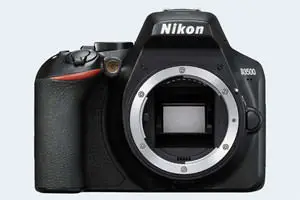Nikon D3300 vs D3500
The Nikon D3300 and the Nikon D3500 are two digital cameras that were revealed to the public, respectively, in January 2014 and August 2018. Both are DSLR (Digital Single Lens Reflex) cameras that are equipped with an APS-C sensor. Both cameras offer a resolution of 24 megapixels.
Below is an overview of the main specs of the two cameras as a starting point for the comparison.

Check D3300 offers at
ebay.com

Check D3500 offers at
ebay.com
Going beyond this snapshot of core features and characteristics, what are the differences between the Nikon D3300 and the Nikon D3500? Which one should you buy? Read on to find out how these two cameras compare with respect to their body size, their imaging sensors, their shooting features, their input-output connections, and their reception by expert reviewers.
Body comparison
An illustration of the physical size and weight of the Nikon D3300 and the Nikon D3500 is provided in the side-by-side display below. The two cameras are presented according to their relative size. Three successive views from the front, the top, and the rear are shown. All width, height and depth dimensions are rounded to the nearest millimeter.
The D3300 can be obtained in three different colors (black, grey, red), while the D3500 is only available in black.
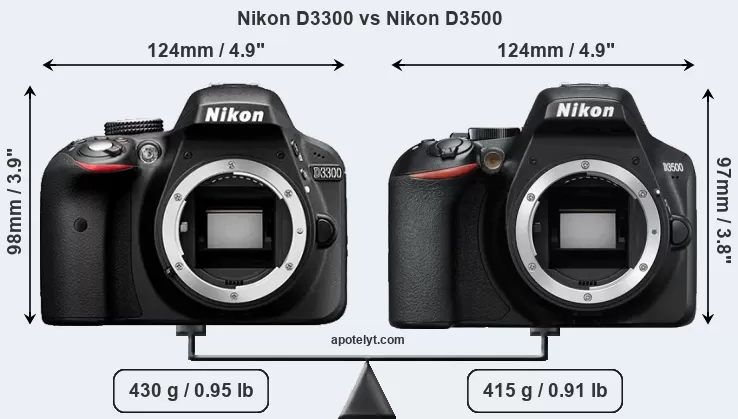

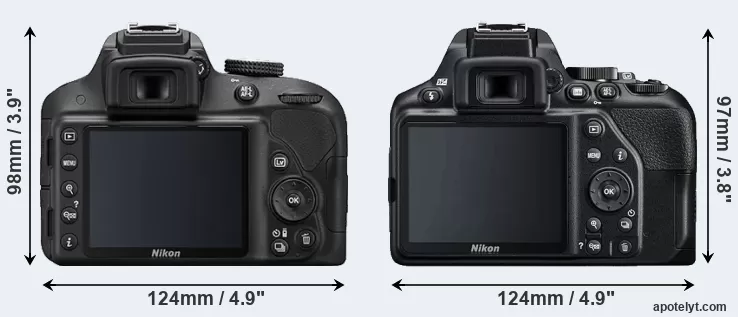
If the front view area (width x height) of the cameras is taken as an aggregate measure of their size, the Nikon D3500 is somewhat smaller (1 percent) than the Nikon D3300. Moreover, the D3500 is slightly lighter (3 percent) than the D3300. In this context, it is worth noting that neither the D3300 nor the D3500 are weather-sealed.
The above size and weight comparisons are to some extent incomplete since they do not consider the interchangeable lenses that both of these cameras require. In this particular case, both cameras feature the same lens mount, so that they can use the same lenses. You can compare the optics available in the Nikon Lens Catalog.
The adjacent table lists the principal physical characteristics of the two cameras alongside a wider set of alternatives. In case you want to display and compare another camera duo, you can use the CAM-parator app to select your camera combination among a large number of options.

| # | Camera Model |
Camera Width |
Camera Height |
Camera Depth |
Camera Weight |
Battery Life |
Weather Sealing |
Camera Launch |
Launch Price (USD) |
Street Price |
|
|---|---|---|---|---|---|---|---|---|---|---|---|
| 1. | Nikon D3300 | 124 mm | 98 mm | 76 mm | 430 g | 700 | n | Jan 2014 | 499 | ebay.com | |
| 2. | Nikon D3500 | 124 mm | 97 mm | 70 mm | 415 g | 1550 | n | Aug 2018 | 429 | ebay.com | |
| 3. | Nikon D5600 | 124 mm | 97 mm | 70 mm | 465 g | 970 | n | Nov 2016 | 699 | ebay.com | |
| 4. | Nikon D3400 | 124 mm | 98 mm | 76 mm | 445 g | 1200 | n | Aug 2016 | 499 | ebay.com | |
| 5. | Nikon D5500 | 124 mm | 97 mm | 70 mm | 470 g | 820 | n | Jan 2015 | 899 | ebay.com | |
| 6. | Nikon D7100 | 136 mm | 107 mm | 76 mm | 765 g | 950 | Y | Feb 2013 | 1,199 | ebay.com | |
| 7. | Nikon D5300 | 125 mm | 98 mm | 76 mm | 480 g | 600 | n | Oct 2013 | 799 | ebay.com | |
| 8. | Nikon D3200 | 125 mm | 96 mm | 77 mm | 505 g | 540 | n | Apr 2012 | 599 | ebay.com | |
| 9. | Sony A5000 | 110 mm | 63 mm | 36 mm | 269 g | 420 | n | Jan 2014 | 449 | ebay.com | |
| 10. | Sony A5100 | 110 mm | 63 mm | 36 mm | 283 g | 400 | n | Aug 2014 | 549 | ebay.com | |
| 11. | Sony A6000 | 120 mm | 67 mm | 45 mm | 344 g | 360 | n | Feb 2014 | 599 | ebay.com | |
| Note: Measurements and pricing do not include easily detachable parts, such as add-on or interchangeable lenses or optional viewfinders. | |||||||||||
Any camera decision will naturally be influenced heavily by the price. The retail prices at the time of the camera’s release place the model in the market relative to other models in the producer’s line-up and the competition. The D3500 was launched at a somewhat lower price (by 14 percent) than the D3300, which makes it more attractive for photographers on a tight budget. Usually, retail prices stay at first close to the launch price, but after several months, discounts become available. Later in the product cycle and, in particular, when the replacement model is about to appear, further discounting and stock clearance sales often push the camera price considerably down.
Sensor comparison
The size of the sensor inside a digital camera is one of the key determinants of image quality. A large sensor will generally have larger individual pixels that offer better low-light sensitivity, provide wider dynamic range, and have richer color-depth than smaller pixels in a sensor of the same technological generation. Moreover, a large sensor camera will give the photographer more control over depth-of-field in the image and, thus, the ability to better isolate a subject from the background. On the downside, larger sensors tend to be more expensive and lead to bigger and heavier cameras and lenses.
Both cameras under consideration feature an APS-C sensor and have a format factor (sometimes also referred to as "crop factor") of 1.5. Within the spectrum of camera sensors, this places the review cameras among the medium-sized sensor cameras that aim to strike a balance between image quality and portability. Both cameras have a native aspect ratio (sensor width to sensor height) of 3:2.
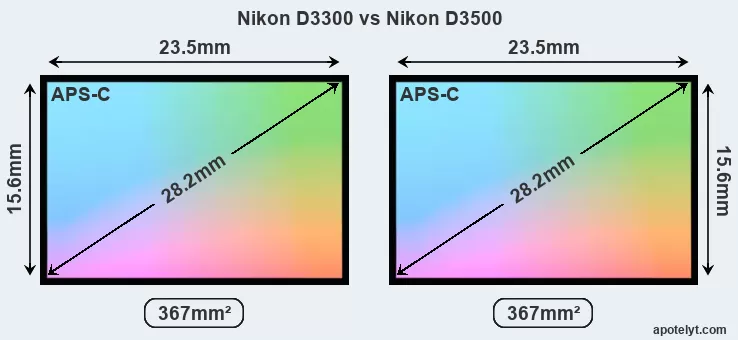
The two cameras under review do not only share the same sensor size, but also offer an identical resolution of 24 megapixels. This similarity in sensor specs implies that both the D3300 and the D3500 have the same pixel density, as well as the same pixel size. It should, however, be noted that the D3500 is much more recent (by 4 years and 7 months) than the D3300, and its sensor will have benefitted from technological advances during this time. Coming back to sensor resolution, it should be mentioned that neither of the two cameras has an anti-alias filter installed, so they are able to capture all the detail the sensor resolves.
The Nikon D3300 has a native sensitivity range from ISO 100 to ISO 12800, which can be extended to ISO 100-25600. The corresponding ISO settings for the Nikon D3500 are ISO 100 to ISO 25600 (no boost).
Technology-wise, both cameras are equipped with CMOS (Complementary Metal–Oxide–Semiconductor) sensors. Both cameras use a Bayer filter for capturing RGB colors on a square grid of photosensors. This arrangement is found in most digital cameras.
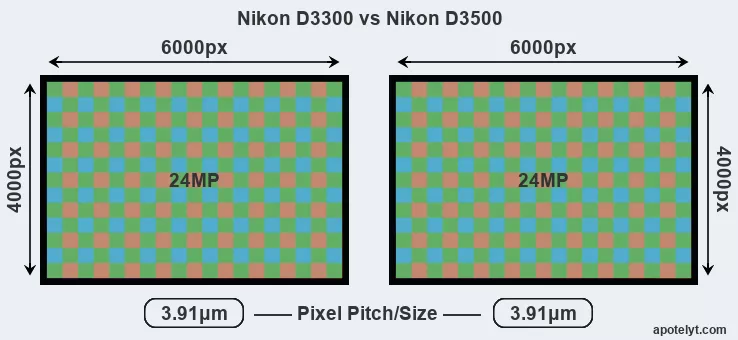
For many cameras, data on sensor performance has been reported by DXO Mark. This service is based on lab testing and assigns an overall score to each camera sensor, as well as ratings for dynamic range ("DXO Landscape"), color depth ("DXO Portrait"), and low-light sensitivity ("DXO Sports"). The following table provides an overview of the physical sensor characteristics, as well as the sensor quality measurements for a selection of comparators.

| # | Camera Model |
Sensor Class |
Resolution (MP) |
Horiz. Pixels |
Vert. Pixels |
Video Format |
DXO Portrait |
DXO Landscape |
DXO Sports |
DXO Overall |
|
|---|---|---|---|---|---|---|---|---|---|---|---|
| 1. | Nikon D3300 | APS-C | 24.0 | 6000 | 4000 | 1080/60p | 24.3 | 12.8 | 1385 | 82 | |
| 2. | Nikon D3500 | APS-C | 24.0 | 6000 | 4000 | 1080/60p | 24.0 | 13.4 | 1851 | 83 | |
| 3. | Nikon D5600 | APS-C | 24.0 | 6000 | 4000 | 1080/60p | 24.1 | 14.0 | 1306 | 84 | |
| 4. | Nikon D3400 | APS-C | 24.0 | 6000 | 4000 | 1080/60p | 24.8 | 13.9 | 1192 | 86 | |
| 5. | Nikon D5500 | APS-C | 24.0 | 6000 | 4000 | 1080/60p | 24.1 | 14.0 | 1438 | 84 | |
| 6. | Nikon D7100 | APS-C | 24.0 | 6000 | 4000 | 1080/60p | 24.2 | 13.7 | 1256 | 83 | |
| 7. | Nikon D5300 | APS-C | 24.0 | 6000 | 4000 | 1080/60p | 24.0 | 13.9 | 1338 | 83 | |
| 8. | Nikon D3200 | APS-C | 24.1 | 6016 | 4000 | 1080/30p | 24.1 | 13.2 | 1131 | 81 | |
| 9. | Sony A5000 | APS-C | 19.8 | 5456 | 3632 | 1080/60i | 23.8 | 13.0 | 1089 | 79 | |
| 10. | Sony A5100 | APS-C | 24.0 | 6000 | 4000 | 1080/60p | 23.8 | 12.7 | 1347 | 80 | |
| 11. | Sony A6000 | APS-C | 24.0 | 6000 | 4000 | 1080/60p | 24.1 | 13.1 | 1347 | 82 | |
| Note: DXO values in italics represent estimates based on sensor size and age. | |||||||||||
Many modern cameras are not only capable of taking still images, but also of capturing video footage. The two cameras under consideration both have sensors whose read-out speed is fast enough to capture moving pictures, and both provide the same movie specifications (1080/60p).
Feature comparison
Apart from body and sensor, cameras can and do differ across a range of features. The D3300 and the D3500 are similar in the sense that both have an optical viewfinder. The latter is useful for getting a clear image for framing even in brightly lit environments. The viewfinders of both cameras offer the same field of view (95%), as well as the same magnification (0.57x). The following table reports on some other key feature differences and similarities of the Nikon D3300, the Nikon D3500, and comparable cameras.

| # | Camera Model |
Viewfinder (Type or 000 dots) |
Control Panel (yes/no) |
LCD Specifications (inch/000 dots) |
LCD Attach- ment |
Touch Screen (yes/no) |
Max Shutter Speed * |
Max Shutter Flaps * |
Built-in Flash (yes/no) |
Built-in Image Stab |
|
|---|---|---|---|---|---|---|---|---|---|---|---|
| 1. | Nikon D3300 | optical | n | 3.0 / 921 | fixed | n | 1/4000s | 5.0/s | Y | n | |
| 2. | Nikon D3500 | optical | n | 3.0 / 921 | fixed | n | 1/4000s | 5.0/s | Y | n | |
| 3. | Nikon D5600 | optical | n | 3.2 / 1037 | swivel | Y | 1/4000s | 5.0/s | Y | n | |
| 4. | Nikon D3400 | optical | n | 3.0 / 921 | fixed | n | 1/4000s | 5.0/s | Y | n | |
| 5. | Nikon D5500 | optical | n | 3.2 / 1037 | swivel | Y | 1/4000s | 5.0/s | Y | n | |
| 6. | Nikon D7100 | optical | Y | 3.2 / 1229 | fixed | n | 1/8000s | 6.0/s | Y | n | |
| 7. | Nikon D5300 | optical | n | 3.2 / 1037 | swivel | n | 1/4000s | 5.0/s | Y | n | |
| 8. | Nikon D3200 | optical | n | 3.0 / 921 | fixed | n | 1/4000s | 4.0/s | Y | n | |
| 9. | Sony A5000 | none | n | 3.0 / 461 | tilting | n | 1/4000s | 3.5/s | Y | n | |
| 10. | Sony A5100 | none | n | 3.0 / 922 | tilting | Y | 1/4000s | 6.0/s | Y | n | |
| 11. | Sony A6000 | 1440 | n | 3.0 / 922 | tilting | n | 1/4000s | 11.0/s | Y | n | |
| Note: *) Information refers to the mechanical shutter, unless the camera only has an electronic one. | |||||||||||
Concerning the storage of imaging data, both the D3300 and the D3500 write their files to SDXC cards. Both cameras can use UHS-I cards, which provide for Ultra High Speed data transfer of up to 104 MB/s.
Connectivity comparison
For some imaging applications, the extent to which a camera can communicate with its environment can be an important aspect in the camera decision process. The table below provides an overview of the connectivity of the Nikon D3300 and Nikon D3500 and, in particular, the interfaces the cameras (and selected comparators) provide for accessory control and data transfer.

| # | Camera Model |
Hotshoe Port |
Internal Mic / Speaker |
Microphone Port |
Headphone Port |
HDMI Port |
USB Port |
WiFi Support |
NFC Support |
Bluetooth Support |
|
|---|---|---|---|---|---|---|---|---|---|---|---|
| 1. | Nikon D3300 | Y | mono / mono | Y | - | mini | 2.0 | - | - | - | |
| 2. | Nikon D3500 | Y | mono / mono | - | - | mini | 2.0 | - | - | Y | |
| 3. | Nikon D5600 | Y | stereo / mono | Y | - | mini | 2.0 | Y | Y | Y | |
| 4. | Nikon D3400 | Y | mono / mono | - | - | mini | 2.0 | - | - | Y | |
| 5. | Nikon D5500 | Y | stereo / mono | Y | - | mini | 2.0 | Y | - | - | |
| 6. | Nikon D7100 | Y | stereo / mono | Y | Y | mini | 2.0 | - | - | - | |
| 7. | Nikon D5300 | Y | stereo / mono | Y | - | mini | 2.0 | Y | - | - | |
| 8. | Nikon D3200 | Y | mono / mono | Y | - | mini | 2.0 | - | - | - | |
| 9. | Sony A5000 | - | stereo / mono | - | - | micro | 2.0 | Y | Y | - | |
| 10. | Sony A5100 | - | stereo / mono | - | - | micro | 2.0 | Y | Y | - | |
| 11. | Sony A6000 | Y | stereo / mono | - | - | micro | 2.0 | Y | Y | - |
It is notable that the D3300 has a microphone port, which is missing on the D3500. Such an external microphone input can help to substantially improve the quality of audio recordings when a good external microphone is used.
Both the D3300 and the D3500 have been discontinued, but can regularly be found used on ebay. The D3300 was replaced by the Nikon D3400, while the D3500 does not have a direct successor. Further information on the features and operation of the D3300 and D3500 can be found, respectively, in the Nikon D3300 Manual (free pdf) or the online Nikon D3500 Manual.
Review summary
So what is the bottom line? Is the Nikon D3300 better than the Nikon D3500 or vice versa? A synthesis of the relative strong points of each of the models is listed below.
Reasons to prefer the Nikon D3300:
- Better sound: Can connect to an external microphone for higher quality sound recording.
- More heavily discounted: Has been available for much longer (launched in January 2014).
Arguments in favor of the Nikon D3500:
- Longer lasting: Gets more shots (1550 versus 700) out of a single battery charge.
- Easier wireless transfer: Supports Bluetooth for image sharing without cables.
- More affordable: Was released into a lower priced segment (14 percent cheaper at launch).
- More modern: Reflects 4 years and 7 months of technical progress since the D3300 launch.
If the number of relative strengths (bullet points above) is taken as a guide, the D3500 emerges as the winner of the match-up (4 : 2 points). However, the pertinence of the various camera strengths will differ across photographers, so that you might want to weigh individual camera traits according to their importance for your own imaging needs before making a camera decision. A professional wedding photographer will view the differences between cameras in a way that diverges from the perspective of a travel photog, and a person interested in cityscapes has distinct needs from a macro shooter. Hence, the decision which camera is best and worth buying is often a very personal one.
How about other alternatives? Do the specifications of the Nikon D3300 and the Nikon D3500 place the cameras among the top in their class? Find out in the latest Best DSLR Camera listing whether the two cameras rank among the cream of the crop.
In any case, while the comparison of technical specifications can provide a useful overview of the capabilities of different cameras, it remains partial and cannot reveal, for example, the shooting experience and imaging performance when actually working with the D3300 or the D3500. User reviews, such as those found at amazon, can sometimes inform about these issues, but such feedback is often incomplete, inconsistent, and biased.
Expert reviews
This is why expert reviews are important. The following table reports the overall ratings of the cameras as published by some of the major camera review sites (amateurphotographer [AP], cameralabs [CL], digitalcameraworld [DCW], dpreview [DPR], ephotozine [EPZ], photographyblog [PB]). As can be seen, the professional reviewers agree in many cases on the quality of different cameras, but sometimes their assessments diverge, reinforcing the earlier point that a camera decision is often a very personal choice.

| # | Camera Model |
AP score |
CL score |
DCW score |
DPR score |
EPZ score |
PB score |
Camera Launch |
Launch Price (USD) |
Street Price |
|
|---|---|---|---|---|---|---|---|---|---|---|---|
| 1. | Nikon D3300 | 3/5 | + | .. | 77/100 | 4.5/5 | 4.5/5 | Jan 2014 | 499 | ebay.com | |
| 2. | Nikon D3500 | 4/5 | .. | 4/5 | 75/100 | 4/5 | 4.5/5 | Aug 2018 | 429 | ebay.com | |
| 3. | Nikon D5600 | 4/5 | .. | 4/5 | 79/100 | 4.5/5 | 4/5 | Nov 2016 | 699 | ebay.com | |
| 4. | Nikon D3400 | 4/5 | + | 4/5 | 76/100 | 4/5 | 4.5/5 | Aug 2016 | 499 | ebay.com | |
| 5. | Nikon D5500 | 5/5 | + | .. | 79/100 | 4.5/5 | 4.5/5 | Jan 2015 | 899 | ebay.com | |
| 6. | Nikon D7100 | 5/5 | + + | .. | 85/100 | 4.5/5 | 4.5/5 | Feb 2013 | 1,199 | ebay.com | |
| 7. | Nikon D5300 | 4/5 | + + | .. | 79/100 | 4.5/5 | 4.5/5 | Oct 2013 | 799 | ebay.com | |
| 8. | Nikon D3200 | 5/5 | + + | .. | 73/100 | 4.5/5 | 4.5/5 | Apr 2012 | 599 | ebay.com | |
| 9. | Sony A5000 | 3/5 | + | .. | .. | 4.5/5 | 4.5/5 | Jan 2014 | 449 | ebay.com | |
| 10. | Sony A5100 | 4.5/5 | + | .. | .. | 4.5/5 | 5/5 | Aug 2014 | 549 | ebay.com | |
| 11. | Sony A6000 | 5/5 | + | 4.5/5 | 80/100 | 4.5/5 | 5/5 | Feb 2014 | 599 | ebay.com | |
| Note: (+ +) highly recommended; (+) recommended; (o) reviewed; (..) not available. | |||||||||||
The review scores listed above should be treated with care, though. The ratings are only valid when referring to cameras in the same category and of the same age. Thus, a score needs to be put into the context of the launch date and the launch price of the camera, and comparisons of ratings among very different cameras or across long time periods have little meaning. Also, please note that some of the review sites have changed their methodology and reporting over time.

Check D3300 offers at
ebay.com

Check D3500 offers at
ebay.com
Other camera comparisons
Did this review help to inform your camera decision process? In case you would like to check on the differences and similarities of other camera models, just use the search menu below. As an alternative, you can also directly jump to any one of the listed comparisons that were previously generated by the CAM-parator tool.
- Canon 300D vs Nikon D3300
- Canon G5 X vs Nikon D3500
- Canon G7 X vs Nikon D3500
- Fujifilm GFX 50R vs Nikon D3300
- Leica TL vs Nikon D3300
- Leica V-LUX 3 vs Nikon D3300
- Leica X2 vs Nikon D3500
- Nikon D3300 vs Panasonic LX100 II
- Nikon D3300 vs Sony NEX-5R
- Nikon D3500 vs Panasonic ZS70
- Nikon D3500 vs Sony A6600
- Nikon D3500 vs Sony H300
Specifications: Nikon D3300 vs Nikon D3500
Below is a side-by-side comparison of the specs of the two cameras to facilitate a quick review of their differences and common features.
| Camera Model | Nikon D3300 | Nikon D3500 |
|---|---|---|
| Camera Type | Digital single lens reflex | Digital single lens reflex |
| Camera Lens | Nikon F mount lenses | Nikon F mount lenses |
| Launch Date | January 2014 | August 2018 |
| Launch Price | USD 499 | USD 429 |
| Sensor Specs | Nikon D3300 | Nikon D3500 |
| Sensor Technology | CMOS | CMOS |
| Sensor Format | APS-C Sensor | APS-C Sensor |
| Sensor Size | 23.5 x 15.6 mm | 23.5 x 15.6 mm |
| Sensor Area | 366.6 mm2 | 366.6 mm2 |
| Sensor Diagonal | 28.2 mm | 28.2 mm |
| Crop Factor | 1.5x | 1.5x |
| Sensor Resolution | 24 Megapixels | 24 Megapixels |
| Image Resolution | 6000 x 4000 pixels | 6000 x 4000 pixels |
| Pixel Pitch | 3.91 μm | 3.91 μm |
| Pixel Density | 6.55 MP/cm2 | 6.55 MP/cm2 |
| Moiré control | no AA filter | no AA filter |
| Movie Capability | 1080/60p Video | 1080/60p Video |
| ISO Setting | 100 - 12,800 ISO | 100 - 25,600 ISO |
| ISO Boost | 100 - 25,600 ISO | no Enhancement |
| Image Processor | EXPEED 4 | EXPEED 4 |
| DXO Sensor Quality (score) | 82 | .. |
| DXO Color Depth (bits) | 24.3 | .. |
| DXO Dynamic Range (EV) | 12.8 | .. |
| DXO Low Light (ISO) | 1385 | .. |
| Screen Specs | Nikon D3300 | Nikon D3500 |
| Viewfinder Type | Optical viewfinder | Optical viewfinder |
| Viewfinder Field of View | 95% | 95% |
| Viewfinder Magnification | 0.57x | 0.57x |
| LCD Framing | Live View | Live View |
| Rear LCD Size | 3.0inch | 3.0inch |
| LCD Resolution | 921k dots | 921k dots |
| LCD Attachment | Fixed screen | Fixed screen |
| Shooting Specs | Nikon D3300 | Nikon D3500 |
| Focus System | Phase-detect AF | Phase-detect AF |
| Continuous Shooting | 5 shutter flaps/s | 5 shutter flaps/s |
| Shutter Life Expectancy | 100 000 actuations | 100 000 actuations |
| Fill Flash | Built-in Flash | Built-in Flash |
| Storage Medium | SDXC cards | SDXC cards |
| Single or Dual Card Slots | Single card slot | Single card slot |
| UHS card support | UHS-I | UHS-I |
| Connectivity Specs | Nikon D3300 | Nikon D3500 |
| External Flash | Hotshoe | Hotshoe |
| USB Connector | USB 2.0 | USB 2.0 |
| HDMI Port | mini HDMI | mini HDMI |
| Microphone Port | External MIC port | no MIC socket |
| Wifi Support | no Wifi | no Wifi |
| Bluetooth Support | no Bluetooth | Bluetooth built-in |
| Body Specs | Nikon D3300 | Nikon D3500 |
| Battery Type | Nikon EN-EL14a | Nikon EN-EL14a |
| Battery Life (CIPA) | 700 shots per charge | 1550 shots per charge |
| Body Dimensions |
124 x 98 x 76 mm (4.9 x 3.9 x 3.0 in) |
124 x 97 x 70 mm (4.9 x 3.8 x 2.8 in) |
| Camera Weight | 430 g (15.2 oz) | 415 g (14.6 oz) |

Check D3300 offers at
ebay.com

Check D3500 offers at
ebay.com
Did you notice an error on this page? If so, please get in touch, so that we can correct the information.

